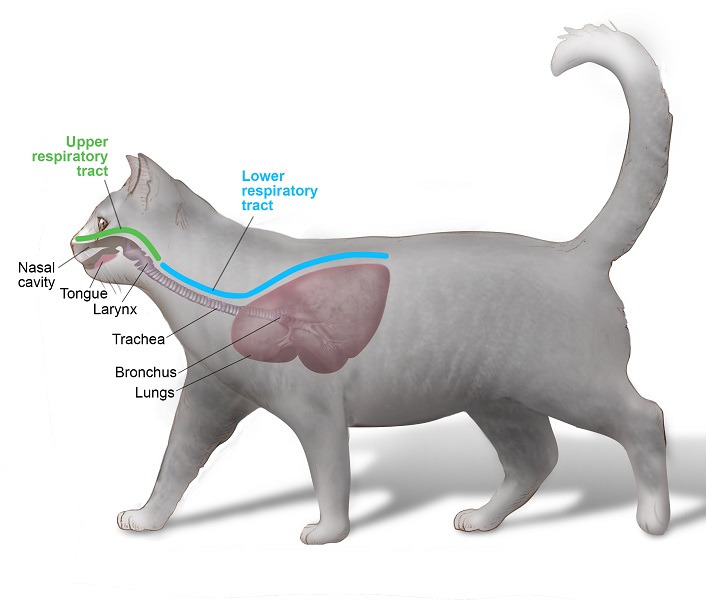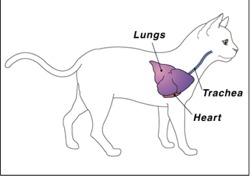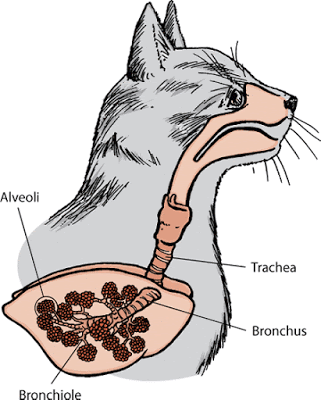
Feline Body Parts – The Lungs of a Cat
Feline lungs are remarkably similar to a human’s lungs. For example, the lungs occupy most of the space in the chest cavity, lying on both sides of the heart, just like they do in humans.
In my mind, I think of the lungs as being divided into two portions – the airways, and the lung tissue. An easy way to understand it is to imagine a tree in full bloom. The trunk of the tree is like the trachea (windpipe). Imagine the trunk goes up a bit, and then divides into two big branches. Those are the main bronchi. Those big branches give rise to smaller branches. Those are the bronchioles. Those branches divide into smaller and smaller branches, which is exactly what happens to the bronchioles in the lungs. Finally, think of the leaves that grow on all of the small branches as the lung tissue that surrounds the little bronchioles. The trunk, branches and twigs are the airways; the leaves are the lung tissue. (At this point you may just be visualizing a bunch of cats in trees. That’s close enough.)
You can break down the function of the lung into two main jobs: ventilation and perfusion. Ventilation is breathing – the movement of air in and out of the lungs. Perfusion is the process by which the lung absorbs oxygen from the air into the blood stream and exchanges it for carbon dioxide, which is exhaled into the environment. Most of the time, ventilation and perfusion are both happening correctly and simultaneously, allowing the blood to receive the proper amount of oxygen for delivery to the vital organs. When something goes wrong with the lungs there could be an airway problem, which can affect ventilation, or a problem with the lung tissue itself, which can affect perfusion. For example, a common lung disorder in cats is bronchitis. Infectious bronchitis is due to an infection (usually bacterial) of the airways. The infection causes impaired flow of air through the airways. This affects ventilation. Asthma is a type of bronchitis caused by an allergy to something in the environment. When a cat breathes in an allergen, it causes the airways to constrict. It becomes harder for air to pass through these narrowed airways. The cells lining the airways become irritated by the allergen, and they will produce mucus, which may plug the already narrowed airways. Clearly, asthma affects ventilation. Infectious bronchitis is treated with antibiotics. Asthma is treated with anti-inflammatory drugs and drugs that dilate the airways, making it easier to breathe. Of course, the best treatment for asthma would be to remove the offending allergen from the environment (cigarette smokers, take the hint), although identifying the allergen can be difficult.
SEE ALSO: Feline Asthma

An example of a problem with the lung tissue itself would be a bacterial infection of the lungs. This is called pneumonia. When the lung tissues get infected and the lung fills with pus, it prevents oxygen from being absorbed into the bloodstream and carbon dioxide from being removed. Another condition affecting the lung tissue is pulmonary edema. In this disorder, the lung fills with fluid, which impairs perfusion similar to the way pneumonia does. Pulmonary edema usually occurs as a result of heart failure. Pneumonia is treated with antibiotics. Pulmonary edema is treated with diuretics – drugs designed to remove the fluid from the lungs. If heart disease is the cause, medications to treat the heart are administered as well.
SEE ALSO: Upper Respiratory Infections in Cats / Feline URI
How do we know that a cat is experiencing a lung problem? A primary clinical sign of a lung problem is coughing. Hey, wanna drive a veterinarian crazy? Tell him that your cat is trying to “cough up a hairball”. Hairballs come from the stomach. Cats vomit up hairballs; they do not “cough” them up. If your cat hunkers down, extends his neck, and makes several raspy throat-clearing sounds, he is coughing, and it is not a hairball. It is likely asthma or bronchitis. Another sign of lung disease is labored breathing. The medical term for this is dyspnea (DISP-nee-uh). If your cat is lying around relaxing, but his chest is moving as if he’s just done a few laps around the jogging track, there’s probably a lung issue going on. He needs veterinary attention immediately. Like, now. Here’s another way to drive your veterinarian batty: tell him your cat has been “wheezing”. Wheezing is the sound of air trying to flow through narrowed airways in the lungs. It’s something you hear when you put a stethoscope up to a cat’s chest. When I’m told a cat is wheezing, I instinctively think “lung problem”. When a cat owner says “wheezing”, they probably mean stertor, which is noisy breathing that occurs during inhalation. It’s a low-pitched sound. In other words, your cat is snoring. This is not a lung problem. Another possibility that the cat has a blockage of the nasal passages (simply put, a stuffy nose), resulting in high pitched, noisy breathing. This is called stridor. Because wheezing usually means lung disease and lung disease is sometimes an emergency, don’t say your cat is wheezing. It freaks us out. Say your cat is congested or has noisy breathing instead. I (and thousands of veterinarians) thank you.

